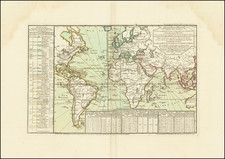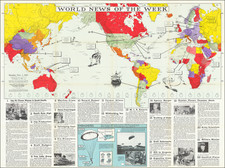Rare English Print From the Collection of an Important 18th Century English Book Collector
Rare allegorical image of the four seasons and for four quarters of the world, offered for sale by a John Overton.
The present image is a rare early engraving, which likely was first issued by Peter Stent, but for which we are unable to locate any surviving examples, either by Stent or Overton.
The image credit is filled with misspellings and references to early London: "Sold by John Overton at the White Horse at ye Corner of Littl Ouldbaley without newgate neere the Fowntane Taverne". These placenames are prevalent in prints offered for sale in London in the second half of the 17th Century and reflect the nexus of activity among some of England's most famous mid-17th Century print sellers and engravers.
The image includes the number 70. We note several other early images bearing John Overton's name with a similar address in the British Museum, including the following images numbered 230 and 127.
- https://www.britishmuseum.org/collection/object/P_2AA-a-67-54
- https://www.britishmuseum.org/collection/object/P_2AA-a-67-77
We note also John Farrer's A Mapp of Virginia Discovered to Ye Hills..., John Goddard Sculp. Domina Virginia Farrer Collegit. Are sold by John Overton without Newgate at the corner of little old Baly," issued sometime after Peter Stent's sale of the copperplate to John Overton.
The above items all would appear to have been part of the copper plate inventory purchased by Overton from Peter Stent who references two separate items 'The 4 seasons of the year' and 'The 4 quarters of the world' in his 1654 catalog, although we have not been able to locate any surviving examples of either set. In his 1662 catalog, Stent also lists two versions of the seasons, one set by Hollar, one by George Glover. The present set is almost certainly not the work of Hollar.
Lee Warly
Lee Warly was the last in a line of family collectors who amassed and important family / parish Library, which would become known as the Elham Library in Kent in 1809.
The Elham library began to be formed in the 17th century as the personal collection of Henry Oxinden of Barham, Kent. Born in 1608, Henry Oxinden was forced to abandon his studies at Oxford after his father's early death and returned to supervise the family estates. He managed to continue his studies through his readings, collecting a wide range of books, including the classics, religious literature in various forms, and, most interestingly, a
number of works of late Elizabethan and Jacobean literature.
Oxinden's library remained with his widow after his death in 1670. After her death it was passed to Katherine Warly, the daughter of his second
wife, his only son having died an ignominious death in the King's Bench Prison in 1668. Katherine was married to John Warly of the parish of Elham, near Canterbury, the parish which was later to receive the library.
When Katherine Warly died in 1717 the library passed to her son John, a surgeon in Canterbury. John Warly added to the collection some more recent
works of medicine and surgery, and the library today has an interesting medical collection. After John Warly's death the library passed to its final and most influential personal owner his son Lee Warly.
Lee Warly was an attorney at law and lived in a house in the very center of Canterbury, the foundations and some walls of which have now been incorporated into a sprawling department store. . . . As well as legal books, Lee Warly bought books of travel, general, local, and religious history, and works of literature.. . . Warly's "acquisitions policy" is spelled out in his own library catalog of 1760. Quoting from Pliny, he states that "the most approved writers of each sort are to be carefully chosen; for, though we should read much, we should not read many books."
Lee Warly died in 1805, a wealthy bachelor age ninety-two. By his will he bequeathed "to the Minister and Church Wardens of the Parish of Elham for the time being, for the whole and sole use of the inhabitants thereof his library of books, with book cases, and writing desk; and also the sum of fifty-pounds, in aid of fitting up a room, for the reception of the same."
Rarity
While we note possible references to the print in Stent catalogs, we have been unable to locate any surviving examples of this engraved image.
The Overton family was a prominent part of the printing, and mapmaking, industry in London in the seventeenth and eighteenth centuries. John Overton (1639/40-1713) was the son of a tailor who apprenticed to Stationer Thomas Gould. He was made free of the Stationers’ Company in 1663. Two years later, London was struck by the Great Plague of 1665-6. Peter Stent, a leading printseller, succumbed and Overton took over his shop. This burned in the Great Fire of 1666, but Overton had rebuilt by 1669, when he advertised his wares from the White Horse on Snow Hill. Overton specialized in prints, portraits, and especially maps and topographical views.
John was likely married three times and had seven children. His eldest, Thomas, emigrated to America. His second oldest, Henry, was executor of John’s will when the latter died in 1713. Henry (1675/6-1751) acquired his father’s stock in 1707 and ran the shop until his own death in 1751. He published many maps, most focusing on the British Isles. His shop and stock passed to his nephew, another Henry, son of John’s fourth son, James.
Henry the Elder’s brother, Philip (ca. 1681-1745), was also a printer and mapmaker. Philip served as his father’s apprentice and was made free of the Stationers’ in 1702. His father set him up in the trade in 1707 and by 1710 he was working from the sign of the Golden Buck in Fleet Street. Philip specialized in fine arts prints, including Hogarth’s Hudibras set (1726), but he also sold many maps. At his death in 1745 he left his shop to his widow, Mary. She ran the shop and then married James Sayer, whose brother, Robert, became Mary’s assistant. He took over the business in 1748 and became a famous purveyor of maps, charts, and views.
Back at the sign of the White Horse, Henry the Younger continued the family business, expanding their stock to include a large collection of landscape views. He often partnered with Robert Sayer. He continued in business until at least 1764, when he drops out of the historical record.











![(16th Century Drake Portrait) Sr. Frauncis Drake knight [Engraved portrait of Sir Francis Drake, with globe, navigational instruments, armillary sphere and a compass]](https://storage.googleapis.com/raremaps/img/small/87606.jpg)


![[ Florida Native Americans Cultivating & Planting ] Culturae & sationis ratio.](https://storage.googleapis.com/raremaps/img/small/81299.jpg)
![(Tallahassee, Florida / Signed by John Quincy Adams) [Certification of full payment by John Boyd for 79 acres of land in Tallahassee, acquired from the General Land Office]](https://storage.googleapis.com/raremaps/img/small/86625.jpg)
![[Early Photographic Facsimile of the 1502 Cantino Planisphere]](https://storage.googleapis.com/raremaps/img/small/67278.jpg)